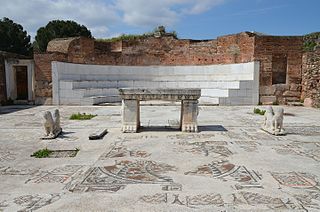
The Epistle to the Hebrews is one of the books of the New Testament.

The Epistle to the Galatians is the ninth book of the New Testament. It is a letter from Paul the Apostle to a number of Early Christian communities in Galatia. Scholars have suggested that this is either the Roman province of Galatia in southern Anatolia, or a large region defined by Galatians, an ethnic group of Celtic people in central Anatolia. The letter was originally written in Koine Greek and later translated into other languages.

The Epistle to the Romans is the sixth book in the New Testament, and the longest of the thirteen Pauline epistles. Biblical scholars agree that it was composed by Paul the Apostle to explain that salvation is offered through the gospel of Jesus Christ.
The New Testament (NT) is the second division of the Christian biblical canon. It discusses the teachings and person of Jesus, as well as events relating to first-century Christianity. The New Testament's background, the first division of the Christian Bible, is called the Old Testament, which is based primarily upon the Hebrew Bible; together they are regarded as sacred scripture by Christians.

Paul, commonly known as Paul the Apostle and Saint Paul, was a Christian apostle who spread the teachings of Jesus in the first-century world. For his contributions towards the New Testament, he is generally regarded as one of the most important figures of the Apostolic Age, and he also founded several Christian communities in Asia Minor and Europe from the mid-40s to the mid-50s AD.

Supersessionism, also called replacement theology, is a Christian theological opinion that describes the idea that the Christian Church has superseded the nation of Israel assuming their role as God's covenanted people, thus asserting that the New Covenant through Jesus Christ has superseded or replaced the Mosaic covenant. Supersessionism also holds that the universal Christian Church has replaced ancient Israel as God's true Israel and that Christians have replaced the biological bloodline of ancient Israelites as the people of God.

The Council of Jerusalem or Apostolic Council is a council described in chapter 15 of the Acts of the Apostles, allegedly held in Jerusalem around c. 48–50 AD.

Jewish Christians were the followers of a Jewish religious sect that emerged in Judea during the late Second Temple period. These Jews believed Jesus to be the prophesied Messiah, but maintained the observance of Jewish law. Jewish Christianity is the foundation of Early Christianity, which later developed into Catholic and Eastern Orthodox Christianity. Christianity started with Jewish eschatological expectations, and it developed into the worship of Jesus as the result of his earthly ministry, his crucifixion, and the post-crucifixion experiences of his followers. Modern scholarship is engaged in an ongoing debate as to the proper designation for Jesus' first followers. Many see the term Jewish Christians as anachronistic given that there is no consensus on the date of the birth of Christianity. Some modern scholars have suggested the designations "Jewish believers in Jesus" or "Jewish followers of Jesus" as better reflecting the original context.

The Judaizers were a faction of the Jewish Christians, both of Jewish and non-Jewish origins, who regarded the Levitical laws of the Old Testament as still binding on all Christians. They tried to enforce Jewish circumcision upon the Gentile converts to early Christianity and were strenuously opposed and criticized for their behavior by the Apostle Paul, who employed many of his epistles to refute their doctrinal positions.

The "New Perspective on Paul" is a movement within the field of biblical studies concerned with the understanding of the writings of the Apostle Paul. The "new perspective" was started with scholar E. P. Sanders' 1977 work Paul and Palestinian Judaism. The old Protestant perspective claims that Paul advocates justification through faith in Jesus Christ over justification through works of the Law. After the Reformation, this perspective was known as sola fide; this was traditionally understood as Paul arguing that Christians' good works would not factor into their salvation – only their faith would count. In this perspective, first-century Second Temple Judaism is dismissed as sterile and legalistic.

Paula Fredriksen is an American historian and scholar of early Christianity. She held the position of William Goodwin Aurelio Professor of Scripture at Boston University from 1990 to 2010. Now emerita, she has been distinguished visiting professor in the Department of Comparative Religion at the Hebrew University of Jerusalem, since 2009.

Dual-covenant or two-covenant theology is a school of thought in Christian theology regarding the relevance of the Hebrew Bible, which Christians call the Old Testament.
The doctrine of the Trinity, considered the core of Christian theology by Trinitarians, is the result of continuous exploration by the church of the biblical data, thrashed out in debate and treatises, eventually formulated at the First Council of Nicaea in AD 325 in a way they believe is consistent with the biblical witness, and further refined in later councils and writings. The most widely recognized Biblical foundations for the doctrine's formulation are in the Gospel of John, which possess ideas reflected in Platonism and Greek philosophy.

The Mosaic covenant or Law of Moses – which Christians generally call the "Old Covenant" – played an important role in the origins of Christianity and has occasioned serious dispute and controversy since the beginnings of Christianity: note for example Jesus' teaching of the Law during his Sermon on the Mount and the circumcision controversy in early Christianity.

God-fearers or God-worshippers were a numerous class of Gentile sympathizers to Hellenistic Judaism that existed in the Greco-Roman world, which observed certain Jewish religious rites and traditions without becoming full converts to Judaism. The concept has precedents in the proselytes of the Hebrew Bible.
The controversy on religious male circumcision in early Christianity has played an important role in the history of Christianity and Christian theology.
The incident at Antioch was an Apostolic Age dispute between the apostles Paul and Peter which occurred in the city of Antioch around the middle of the first century. The primary source for the incident is Paul's Epistle to the Galatians 2:11–14. Since the 19th century figure Ferdinand Christian Baur, biblical scholars have found evidence of conflict among the leaders of early Christianity; for example, James D. G. Dunn proposes that Peter was a "bridge-man" between the opposing views of Paul and James, brother of Jesus. The final outcome of the incident remains uncertain, resulting in several Christian views on the Old Covenant.

Since the 1970s, scholars have sought to place Paul the Apostle within his historical context in Second Temple Judaism. Paul's relationship to Judaism involves topics including the status of Israel's covenant with God and the role of works as a means to either gain or keep the covenant.

Christianity in the 1st century covers the formative history of Christianity from the start of the ministry of Jesus to the death of the last of the Twelve Apostles and is thus also known as the Apostolic Age. Early Christianity developed out of the eschatological ministry of Jesus. Subsequent to Jesus' death, his earliest followers formed an apocalyptic messianic Jewish sect during the late Second Temple period of the 1st century. Initially believing that Jesus' resurrection was the start of the end time, their beliefs soon changed in the expected Second Coming of Jesus and the start of God's Kingdom at a later point in time.
Paul's theology is considered by some interpreters to center on a participation in Christ, in which one partakes in salvation by dying and rising with Jesus. While this theology was interpreted as mysticism by Albert Schweitzer, according to the New Perspective on Paul, as initiated by E.P. Sanders, it is more aptly viewed as a salvation theology.












